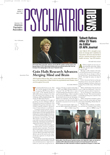A new convulsive technique, magnetic seizure therapy (MST), is undergoing preliminary trials as a potential treatment for severe depression.
“The advantages of MST are that it uses rapidly alternating strong magnetic fields instead of electrical current and offers greater control of intracerebral current density than is possible with electroconvulsive therapy [ECT],” Sarah H Lisanby, M.D. told Psychiatric News. “We are testing whether MST could give an antidepressant response comparable to ECT but without its deleterious side effects.”
Lisanby is director of the magnetic stimulation laboratory in the department of biological psychiatry at the New York State Psychiatric Institute and an associate professor of psychiatry at Columbia University College of Physicians and Surgeons.
In a randomized within-subject comparison of MST with ECT, MST was found to be safe and well tolerated in a clinical setting. More significantly, MST had a superior, acute, cognitive side-effect profile to ECT. MST-induced seizures were shorter, and patients had fewer subjective side effects and recovered orientation faster than with ECT. Moreover, patients performed better on tests of attention, retrograde amnesia, and category fluency after MST than after ECT.
In studies funded by the Stanley Foundation, the American Federation for Aging Research (AFAR), and National Alliance for Research on Schizophrenia and Depression, 35 patients have been treated so far. Further trials are planned to evaluate the efficacy of MST in treating depression.
While ECT therapy is indispensable for treating certain forms of severe depression, it requires a strong electrical current, because the impedance of the skull shunts most of it (80 percent to 97 percent) away from the brain. ECT also produces a generalized seizure, and the antidepressant effect can vary widely from below 20 percent up to 70 percent.
Transcranial magnetic stimulation (TMS) has been proposed as a way to get around these drawbacks because the skull is transparent to magnetic fields. Although the electrical field induced by TMS depolarizes nerve cells only in the cortex, the resulting seizures are more focal than those produced by ECT (Psychiatric News, May 7).
All of these factors suggest that MST would have more control over the current path and current density in the brain than ECT.
MST-induced seizures require a higher frequency than standard TMS stimulators (40 Hz) to overcome the anticonvulsive effects of anesthetics given during convulsive therapy.
Since MST offers the advantage of being able to direct a train of current to where the seizure will take place and with much less current than ECT, if the deleterious side effects of ECT are caused by electrical current being shunted to parts of the brain different from the site involved in depression, it might be possible to direct the seizures to areas where they will do the most good and spare other parts where seizures would produce undesirable side effects. If that is what occurs, then MST would have the potential of being as effective as ECT with few or none of ECT's side effects.
Commented Mark George, M.D., an associate professor of psychiatry, radiology, and neurology and director of the function imaging division in psychiatry at the Medical University of South Carolina in Charleston:“ Lisanby and Sackeim have taken advantage of the fact that the skull is transparent to magnetic fields and have pioneered the idea of using a very powerful TMS device to produce high frequencies that can cause seizures. The big question is whether MST works as an antidepressant.”
He told Psychiatric News that one of MST's drawbacks is that it requires the use of general anesthesia to produce a seizure, which increases risk and expense. MST also needs a very high stimulation frequency, so the investigators had to develop new technology much more powerful than TMS to get an MST-type seizure.
“The big theoretical interest is that with MST there is now a way of focally producing a seizure. With TMS we have a way of going to regions of the brain and tickling them—turning them on and off—without producing a seizure. Now we might begin to settle the issue of whether you need a seizure or not to treat depression,” he said.
The fact that some studies suggest that repetitive TMS can result in a subconvulsive antidepressant effect with frequencies as low as 1-4 Hz challenges the view that a seizure is necessary for brain-stimulation techniques to exert antidepressant effects.
“Since you can treat depression with low frequency rTMS, why do you need to produce seizures with high frequency MST? What does it do differently from nonseizure therapy? And what are the brain regions to stimulate? All these questions need to be answered,” he said.
“What's exciting for me—whether we need a seizure or not to get an antidepressant effect—has been debated back and forth for years. Now the technologies are moving in a direction that within a few years we might be able to answer that.... Hopefully, we might be able to spin off one or many ways of treating depression successfully. It's all very exciting.”
Lisanby added that the antidepressant efficacy of subconvulsive TMS is under study. “It may be that some patients with more severe depression will continue to need a more robust and definitive treatment. Therefore, I do not see it as an either-or situation, but rather that we should develop all potentially helpful avenues for using brain stimulation to treat depression.”
An abstract of the study, “Safety and Feasibility of Magnetic Seizure Therapy (MST) in Major Depression: Randomized Within-Subject Comparison With Electroconvulsive Therapy,” is posted online at<www.nature.com/cgi-taf/DynaPage.taf?file=/npp/journal/v28/n10/abs/1300229a.html>.▪
